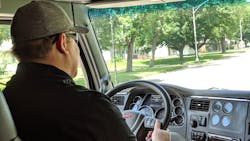LAS VEGAS—Through a global customer advisory group session last year, Geotab discovered that the No. 1 reason its customers use telematics is for safety. Because of this, Mike Branch, Geotab’s VP of data and analytics, said Geotab’s focus in 2023 was to improve its safety offering, and the result is its Geotab Safety Center, announced here during its user conference.
This new Geotab offering takes driver scoring to a new level. Currently, the industry norm for driver scoring is a driver scorecard. Many scorecards connect to fleet management systems that track speeding, harsh braking and accelerating, cornering, and more. If drivers exhibit any of these behaviors, their scorecards are negatively affected.
See also: Coach drivers to meet emissions regulations, ESG goals
Scorecards sound cut and dry—almost like a perfect system. Yet driver behaviors often deemed poor aren’t always as bad as they seem. It depends on the context.
An example is if a driver is cut off by another motorist on the road, triggering a harsh braking event. The harsh brake was necessary to prevent a collision, but if the data system didn’t consider context, the driver would be negatively affected.
Video telematics has helped address this context problem, but the problem persists. With the Geotab Safety Center, context is a top priority, starting with telematics’ ABCs. Branch said the ABCs of telematics and measuring driver safety are harsh braking and acceleration.
“If you’re harsh accelerating, and you’re going on the on-ramp, that’s probably OK,” Branch said. “What does it look like when you’re driving in the wintertime and weather and snow? This context makes so much of a difference. ... We’ve taken those ABCs (of telematics) and we put context on top of that.”
This solution is an alternative to driver scorecards, and the additional context provides insights that fleet managers can use to coach their drivers better.
“Driver scores worked in terms of helping improve to a degree, but there’s a point where maybe that will plateau,” Sabina Martin, Geotab VP of product management, told FleetOwner. “This model will allow us to be a little bit more specific and provide more focus areas from a risk perspective that you can coach drivers to with that additional context.”
Accurately weighing driver behaviors
Having context matters because of the way fleet managers score their drivers.
Geotab founder and CEO Neil Cawse said scoring drivers is necessary, but the current system, having humans weigh behaviors, is flawed.
Branch expanded on this sentiment. “The problem that (fleet managers) have right now is they don’t know what percentage weighting to put on things,” he told FleetOwner. “You’re asking a fleet manager now to say what percentage weighting should you put on scoring a seatbelt or harsh braking.”
Cawse believes the solution to the problem is to take human opinion out of the equation entirely. “We need to base (behavior weight scoring) on data, and we need to go based on what the analysis shows us of the 4 million vehicles” connected in Geotab’s network.
Using artificial intelligence and Geotab and its integration partners’ data, the Geotab Safety Center can take out all the guesswork for fleet managers.
“Knowing what weighting, what percentage to put on these scores is a tricky thing for a fleet,” Branch told FleetOwner. “How do you know what is right or wrong? You have to leverage the model to be able to tell you what those (context) factors are.”
See also: New Year’s Resolution: Prioritize driver health and safety
Branch said the fleets that have tested the Geotab Safety Center appreciate that driver behaviors are now prescribed a specific score and that the system indicates to fleet managers which drivers need coaching. He said they also love that the system compares the fleet’s performance to Geotab’s customer base.
This is significant because “you can always benchmark against yourself,” Branch said. “You can see, ‘Hey, we’re doing better.’ But are you doing better but still consistently below the benchmark, below the average?”
It has visibility into the benchmark, allowing fleets to make decisions based on broader metrics.
“You want to know how you fare against others; otherwise, you end up making a decision based on a microcosm of this is one fleet,” Branch said.
The Geotab Safety Center
The Geotab Safety Center is quite advanced. It uses artificial intelligence and data from its partner integrations with video telematics providers such as Lytx, Sensata, and Smarter AI. Geotab condenses this data into a Key Metrics Page that fleet managers will see upon logging into the Safety Center dashboard.
This dashboard is where fleets will see their performance against the Geotab network benchmark, and managers can click on certain aspects, such as collision analytics, to view collision trends and see data month-over-month and year-over-year. If available, fleet managers can even look at specific collisions and access all the data from that event down to its video footage.
The Key Metrics dashboard also offers a collision prediction for the next one million miles. Geotab can offer this collision prediction by “weeding out” the false positives that other systems incur caused by events such as driving over a pothole or a speedbump, Branch explained.
The Geotab Safety Center doesn’t take away from Geotab’s current fleet safety offerings—such as risk event reports, safety scorecard, video telematics, asset tracking, and more—instead it builds upon them. Though Branch sees the Safety Center as a better way to score drivers’ behaviors, he acknowledges that driver safety scorecards won’t go away soon.
“We’re going to still have people who will use their safety scorecards because it’s what they’re used to,” Branch told FleetOwner. “But we have noticed a significant portion of the beta testers were very eager to leverage and start moving into this new world because, ultimately, it’s about lowering the collision rate.”
See also: Using safety technology to achieve operational excellence
The Geotab Safety Center will be available to Geotab customers in March.
About the Author
Jade Brasher
Senior Editor Jade Brasher has covered vocational trucking and fleets since 2018. A graduate of The University of Alabama with a degree in journalism, Jade enjoys telling stories about the people behind the wheel and the intricate processes of the ever-evolving trucking industry.


